Benchmarked - Assassin's Creed: Unity
by Jarred Walton on November 20, 2014 8:30 AM ESTTest System and Benchmarks
With that introduction out of the way, let's just get straight to the benchmarks, and then I'll follow up with a discussion of image quality and other aspects at the end. As usual, the test system is what I personally use, which is a relatively high-end Haswell configuration. Most of the hardware was purchased at retail over the past year or so, and that means I don't have access to every GPU configuration available, but I did just get a second ZOTAC GTX 970 so I can at least finally provide some SLI numbers (which I'll add to the previous Benchmarked articles in the near future).
| Gaming Benchmarks Test Systems | |
| CPU | Intel Core i7-4770K (4x 3.5-3.9GHz, 8MB L3) Overclocked to 4.1GHz Underclocked to 3.5GHz with two cores ("i3-4330") |
| Motherboard | Gigabyte G1.Sniper M5 Z87 |
| Memory | 2x8GB Corsair Vengeance Pro DDR3-1866 CL9 |
| GPUs | Desktop GPUs: Sapphire Radeon R9 280 Sapphire Radeon R9 280X Gigabyte Radeon R9 290X EVGA GeForce GTX 770 EVGA GeForce GTX 780 Zotac GeForce GTX 970 Reference GeForce GTX 980 Laptops: GeForce GTX 980M (MSI GT72 Dominator Pro) GeForce GTX 880M (MSI GT70 Dominator Pro) GeForce GTX 870M (MSI GS60 Ghost 3K Pro) GeForce GTX 860M (MSI GE60 Apache Pro) |
| Storage | Corsair Neutron GTX 480GB |
| Power Supply | Rosewill Capstone 1000M |
| Case | Corsair Obsidian 350D |
| Operating System | Windows 7 64-bit |
We're testing with NVIDIA's 344.65 drivers, which are "Game Ready" for Assassin's Creed: Unity. (I also ran a couple sanity checks with the latest 344.75 drivers and found no difference in performance.) On the AMD side, testing was done with the Catalyst 14.11.2 driver that was released to better support ACU. AMD also released a new beta driver for Far Cry 4 and Dragon Age: Inquisition (14.11.2B), but I have not had a chance to check performance with that yet. No mention is made of improvements for ACU with the driver, so it should be the same as the 14.11.2 driver we used.
One final note is that thanks to the unlocked nature of the i7-4770K and the Gigabyte motherboard BIOS, I'm able to at least mostly simulate lower performance Haswell CPUs. I didn't run a full suite of tests with a second "virtual" CPU, but I did configure the i7-4770K to run similar to a Core i3-4330 (3.5GHz, 2C/4T) – the main difference being the CPU still has 8MB L3 cache where the i3-4330 only has 4MB L3. I tested just one GPU with the slower CPU configuration, the GeForce GTX 980, but this should be the best-case result for what you could get from a Core i3-4330.
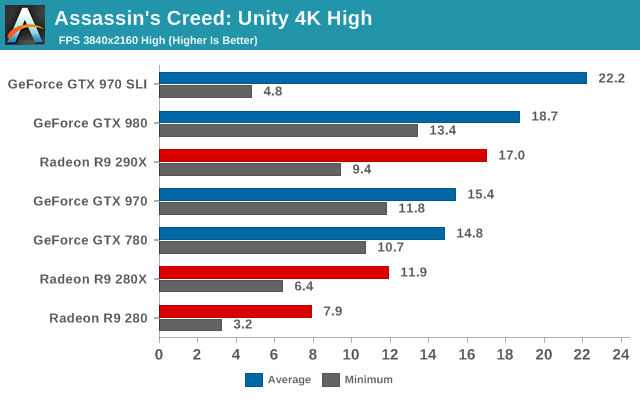
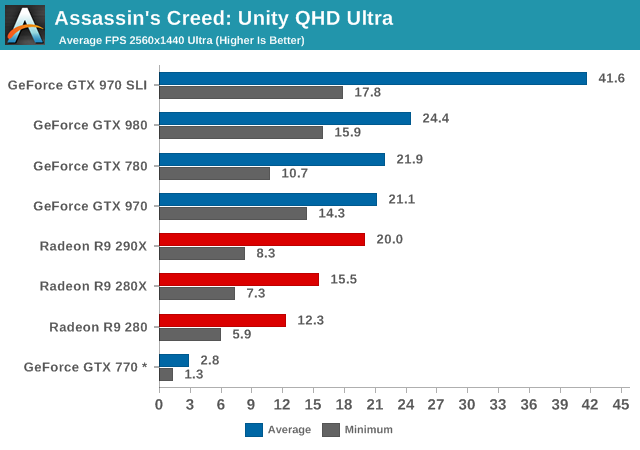
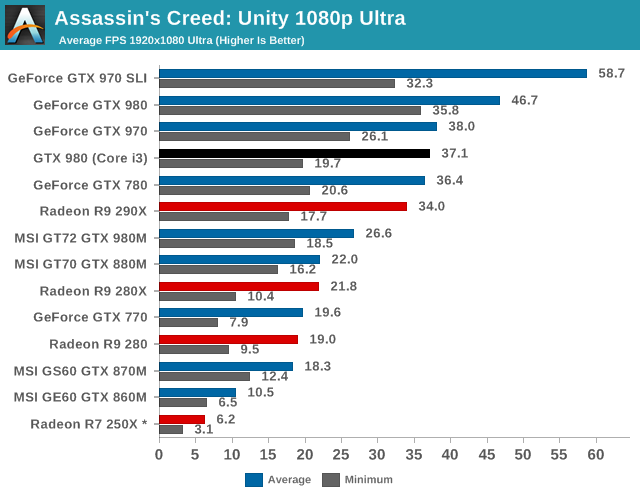
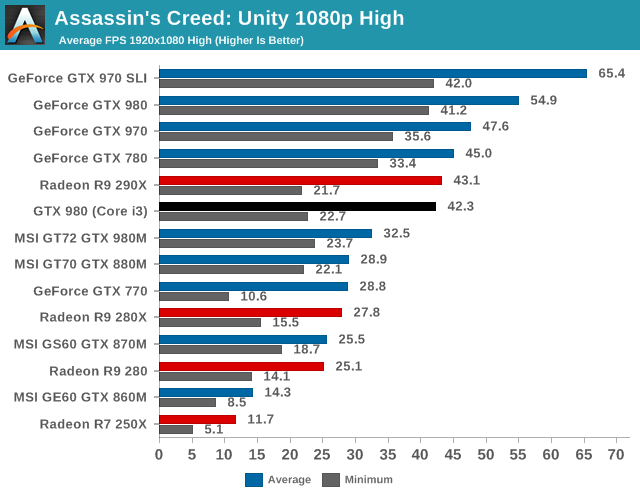
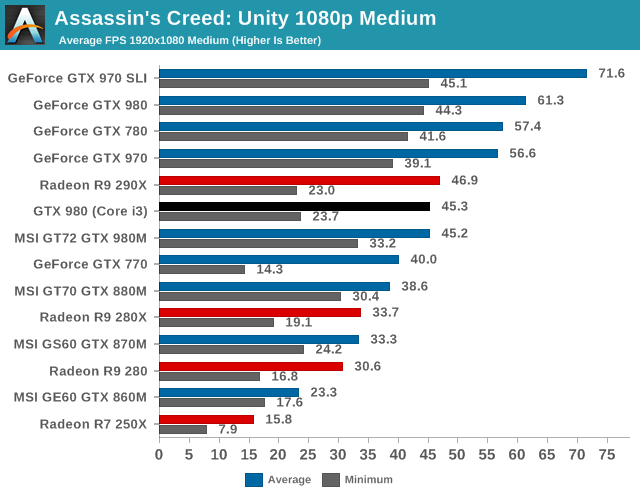
Did I mention that Assassin's Creed: Unity is a beast to run? Yeah, OUCH! 4K gaming is basically out of the question on current hardware, and even QHD is too much at the default Ultra settings. Also notice how badly the GTX 770 does at the Ultra settings, which appears to be due to the 2GB of VRAM; I logged system usage for the GTX 770 at QHD Ultra and found that the game was trying to allocate nearly 3GB of VRAM use, which on a 2GB card means there's going to be a lot of texture thrashing. (4K with High quality also uses around 3GB of VRAM, if you're wondering.) The asterisk is there because I couldn't actually run the benchmark, so I used a "Synchronize" from the top of a tower instead, which is typically slightly less demanding than our actual benchmark run.
Anyway, all of the single GPUs are basically unplayable at QHD Ultra settings, and a big part of that looks to be the higher resolution textures. Dropping the texture quality to High can help, but really the game needs a ton of GPU horsepower to make QHD playable. GTX 970 SLI basically gets there, though again I'd suggest dropping the texture quality to High in order to keep minimum frame rates closer to 30. Even at 1080p, I'd suggest avoiding the Ultra setting – or at least Ultra texture quality – as there's just a lot of stutter. Sadly, the GTX 980M and 880M both have 8GB GDDR5, but their performance with Ultra settings is too low to really be viable, though they do show a bit better minimums relative to the other GPUs.
As we continue down the charts, NVIDIA's GTX 780 and 970 (and faster) cards finally reach the point where performance is totally acceptable at 1080p High (and you can tweak a few settings like turning on HBAO+ and Soft Shadows without too much trouble). What's scary is that looking at the minimum frame rates along with the average FPS, the vast majority of GPUs are still struggling at 1080p High, and it's really only 1080p Medium where most midrange and above GPUs reach the point of playability.
There's a secondary aspect to the charts that you've probably noticed as well. Sadly, AMD's GPUs really don't do well right now with Assassin's Creed: Unity. Some of it is almost certainly drivers, and some of it may be due to the way things like GameWorks come into play. Whatever the cause, ACU is not going to be a great experience on any of the Radeon GPUs right now.
I did some testing of CrossFire R9 290X as well, and while it didn't fail to run, performance was not better than a single 290X – and minimum frame rates were down – so CrossFire (without any attempt to create a custom profile) isn't viable yet. Also note that while SLI "works", there are also rendering issues at times. Entering/exiting the menu/map, or basically any time there's a full screen post processing filter, you get severe flicker (a good example is when you jump off a tower into a hay cart, you'll notice flicker on the peripheral as well as on Arno's clothing). I believe these issues happen on all the multi-GPU rigs, so it might be more of a game issue than a driver issue.
I even went all the way down to 1600x900 Medium to see if that would help any of AMD's GPUs; average frame rates on the R9 290X basically top out at 48FPS with minimums still at 25 or so. I did similar testing on NVIDIA and found that with the overclocked i7-4770K ACU maxes out at just over 75 FPS with minimums of 50+ FPS. We'll have to see if AMD and/or Ubisoft Montreal can get things working better on Radeon GPUs, but for now it's pretty rough. That's not to say the game is unplayable on an R9 290X, as you can certainly run 1080p High, but there are going to be occasional stutters. Anything less than the R9 290/290X and you'll basically want to use Low or Medium quality (with some tweaking).
Finally, I mentioned how 2GB GPUs are really going to have problems, especially at higher texture quality settings. The GeForce GTX 770 is a prime example of this; even at 1080p High, minimum frame rates are consistently dropping into the low teens and occasionally even single digits, and Medium quality still has very poor minimum frame rates. Interestingly, at 1600x900 Medium the minimum FPS basically triples compared to 1080p Medium, so if the game is using more than 2GB VRAM at 1080p Medium it's not by much. This also affects the GTX 860M (1366x768 Low is pretty much what you need to run on that GPU), and the 1GB R7 250X can't even handle that. And it probably goes without saying, but Intel's HD 4600 completely chokes with ACU – 3-7 FPS at 1366x768 is all it can manage.
What About the CPU?
I mentioned earlier that I also underclocked the Core i7-4770K and disabled a couple CPU cores to simulate a Core i3-4330. It's not a fully accurate simulation, but just by way of reference the multi-threaded Cinebench 11.5 score went from 8.08 down to 3.73, which looks about right give or take a few percent. I only tested the GTX 980 with the slower CPU, but this is basically the "best case" for what a Core i3 could do.
Looking at the above 1080p charts, you can see that with the slower CPU the GTX 980 takes quite the hit to performance. In fact, the GTX 980 with a "Core i3" Haswell CPU starts looking an awful lot like the R9 290X: it's playable in a pinch, but the minimum frame rates will definitely create some choppiness at times. I don't have an AMD rig handy to do any testing, unfortunately, but I'd be surprised if the APUs are much faster than the Core i3.
In short, not only do you need a fast GPU, but you also need a fast CPU. And the "just get a $300 console" argument doesn't really work either, as frame rates on the consoles aren't particularly stellar either from what I've read. At least one site has found that both the PS4 and Xbox One fail to maintain a consistent 30FPS or higher frame rate.










122 Comments
View All Comments
poohbear - Friday, November 21, 2014 - link
lets be honest, this is a poorly optimized game with an enormous amount of bugs that was so ridiuclously messed up it made the BBC news and their shares dropped 11%! It's a complete debacle.dwade123 - Friday, November 21, 2014 - link
Good thing I didn't buy GTX 980 for $460. It can't run next genports maxed comfortably. Bring out the real nextgen gpus!maroon1 - Friday, November 21, 2014 - link
Core i3 4130 with GTX 750 Ti runs this game as good as console versionEurogamers did test by matching the graphic quality of PC to console version (by running it with 900p and similar graphic settings to PS4), and the result that GTX 750 Ti plays it as good if not slightly better.
cmdrmonkey - Friday, November 21, 2014 - link
When a game is barely playable on the most high-end video cards on the market at resolutions and settings PC gamers are accustomed to, you have utterly failed. Bravo Ubisoft. Bravo.P39Airacobra - Friday, November 21, 2014 - link
You can forget about Ubicrap fixing this! This is why Ubicrap gave the unreal PC requirements! They are getting money from GPU/CPU Hardware to help market for them! And they do care to spend more money on us scum customers anyway! So I say XXXXXXXXXXXX UBICRAP!!!!!P39Airacobra - Friday, November 21, 2014 - link
They should be arrested for doing this!mr. president - Sunday, November 23, 2014 - link
Any chance of testing CPU performance on AMD vs nvidia GPUs? I've seen a *ton* of recent games underperform on AMD GPUs due to what I think is their lack of support for deferred contexts aka 'multithreaded rendering'. It's particularly low-end CPUs that are affected.Unity pushes something like 50.000 draw calls each frame. Note the enormous disparity in minimum framerates between the two vendors on 1080p/medium where even slower nvidia GPUs get higher minimums than faster AMD GPUs. I think it's worth exploring as even low-end FX CPUs can almost double their performance on high-end nvidia GPUs vs. high-end AMD GPUs.
FlushedBubblyJock - Tuesday, November 25, 2014 - link
That last line you have tells me AMD is offloading multiple boatloads of work to the cpu --- isn't that exactly why Mantle is for low end cpu's - it relieves the gigantic overburdening cheaty normal driver of AMD that hammers the puny AMD cpus.It's sad really - shortcuts and angles and scammy drivers that really only hurt everyone.
RafaelHerschel - Sunday, November 23, 2014 - link
A few observations:60 frames per seconds isn’t some arbitrary value. With Vsync enabled and a refresh rate of 60Hz, dips below 60 fps are far more unpleasant. Adaptive Vsync addresses that but isn’t available to everybody. Disabling Vsync leads to screen tearing which some people (me included) find extremely annoying.
In a game every frame consists of discrete information. In a movie each frame is slightly blurred or at least partially blurred, a natural effect of capturing moving objects in a frame. For a game to feel fluent at 24 or 30 fps it needs to add artificial blurring.
In movies each frame has the same length. In games the length of each frame is different. So even 60 fps can feel choppy.
Different people have different sensibilities. I always notice a low frame rate and frame drops. A steady 60 fps with Vsync enabled works best for me. Anything below 50 fps (in a game) feels off to me and above 60 I don’t notice that much difference. Likewise for gaming and movies I use screens with a fast response time since ghosting really distracts me.
I feel that with a decent system a 60 fps minimum should be attainable. What bugs me is that in some games lowering the quality settings has little impact on the minimum frame rate.
I’m always surprised by blanket statement like “30 fps per second is perfectly playable”. Depending on the game, the settings and the person playing the game it’s often not. For me another factor is how close I’m to the screen.
JarredWalton - Monday, November 24, 2014 - link
FWIW, I've been playing games for about 35 years now (since I was 6 on a Magnovox Odyssey II), and when I say a game is "playable" at 40 FPS, what I'm saying is that as someone with years of game playing behind them feels the game works fine at that frame rate. I've also played ACU for many hours at sub-60 FPS rates (without G-SYNC being enabled) and didn't mind the experience. Of course I wasn't the one saying it was "perfectly playable" above, but it is most definitely playable and IMO acceptable for performance. If you want *ideal*, which is completely different, then yes: 60+ FPS is what you want. But then there are those with LCDs running at 120Hz who would want even higher frame rates. YMMV.